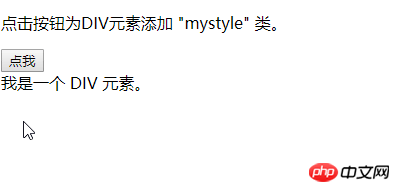 Web Front-end
Web Front-end
 H5 Tutorial
H5 Tutorial
 Detailed explanation of the use of HTML5's classList attribute to operate CSS classes
Detailed explanation of the use of HTML5's classList attribute to operate CSS classes
Detailed explanation of the use of HTML5's classList attribute to operate CSS classes
This article mainly introduces the detailed explanation of using the classList attribute of HTML5 to operate CSS classes. The editor thinks it is quite good, so I will share it with you now and give it as a reference. Let’s follow the editor and take a look.
Preface
In the past, we needed to use some methods of js or jquery, hasClass, addClass, and removeClass, in the class attribute of an element. Adding or deleting certain classes can meet the needs of certain style changes, but it is still a little troublesome.
h5 The new classList allows us to more conveniently operate on the class names of elements.
Note
classList has poor compatibility and is not compatible with IE browsers below IE10.
Example
<!DOCTYPE html>
<html>
<head>
<meta charset="utf-8">
<title>classList</title>
<style>
.mystyle {
width: 300px;
height: 50px;
background-color: red;
color: white;
font-size: 25px;
}
</style>
</head>
<body>
<p>点击按钮为p元素添加 "mystyle" 类。</p>
<button onclick="myFunction()">点我</button>
<p id="myp">
我是一个 p 元素。
</p>
<script>
function myFunction() {
document.getElementById("myp").classList.add("mystyle");
}
</script>
</body>
</html>
##New class
Use add method , you can add one or more classes to page elements:document.getElementById("myp").classList.add("mystyle");Delete a class
document.getElementById("myp").classList.remove("mystyle"); Switch the class name in the element
##
document.getElementById("myp").classList.toggle("classToRemove", false);Add one
document.getElementById("myp").classList.toggle("classToAdd", true);Note: Internet Explorer or Opera 12 and earlier versions do not support the second parameterCheck whether it contains a certain class
Use the contains method to determine whether a certain class exists and return a Boolean value.
//returns true or false
document.getElementById("myp").classList.contains("myp");The above is the detailed content of Detailed explanation of the use of HTML5's classList attribute to operate CSS classes. For more information, please follow other related articles on the PHP Chinese website!

Hot AI Tools

Undresser.AI Undress
AI-powered app for creating realistic nude photos

AI Clothes Remover
Online AI tool for removing clothes from photos.

Undress AI Tool
Undress images for free

Clothoff.io
AI clothes remover

Video Face Swap
Swap faces in any video effortlessly with our completely free AI face swap tool!

Hot Article

Hot Tools

Notepad++7.3.1
Easy-to-use and free code editor

SublimeText3 Chinese version
Chinese version, very easy to use

Zend Studio 13.0.1
Powerful PHP integrated development environment

Dreamweaver CS6
Visual web development tools

SublimeText3 Mac version
God-level code editing software (SublimeText3)

Hot Topics
 1659
1659
 14
14
 1415
1415
 52
52
 1309
1309
 25
25
 1257
1257
 29
29
 1231
1231
 24
24
 How to use bootstrap in vue
Apr 07, 2025 pm 11:33 PM
How to use bootstrap in vue
Apr 07, 2025 pm 11:33 PM
Using Bootstrap in Vue.js is divided into five steps: Install Bootstrap. Import Bootstrap in main.js. Use the Bootstrap component directly in the template. Optional: Custom style. Optional: Use plug-ins.
 Understanding HTML, CSS, and JavaScript: A Beginner's Guide
Apr 12, 2025 am 12:02 AM
Understanding HTML, CSS, and JavaScript: A Beginner's Guide
Apr 12, 2025 am 12:02 AM
WebdevelopmentreliesonHTML,CSS,andJavaScript:1)HTMLstructurescontent,2)CSSstylesit,and3)JavaScriptaddsinteractivity,formingthebasisofmodernwebexperiences.
 The Roles of HTML, CSS, and JavaScript: Core Responsibilities
Apr 08, 2025 pm 07:05 PM
The Roles of HTML, CSS, and JavaScript: Core Responsibilities
Apr 08, 2025 pm 07:05 PM
HTML defines the web structure, CSS is responsible for style and layout, and JavaScript gives dynamic interaction. The three perform their duties in web development and jointly build a colorful website.
 How to insert pictures on bootstrap
Apr 07, 2025 pm 03:30 PM
How to insert pictures on bootstrap
Apr 07, 2025 pm 03:30 PM
There are several ways to insert images in Bootstrap: insert images directly, using the HTML img tag. With the Bootstrap image component, you can provide responsive images and more styles. Set the image size, use the img-fluid class to make the image adaptable. Set the border, using the img-bordered class. Set the rounded corners and use the img-rounded class. Set the shadow, use the shadow class. Resize and position the image, using CSS style. Using the background image, use the background-image CSS property.
 How to write split lines on bootstrap
Apr 07, 2025 pm 03:12 PM
How to write split lines on bootstrap
Apr 07, 2025 pm 03:12 PM
There are two ways to create a Bootstrap split line: using the tag, which creates a horizontal split line. Use the CSS border property to create custom style split lines.
 How to set up the framework for bootstrap
Apr 07, 2025 pm 03:27 PM
How to set up the framework for bootstrap
Apr 07, 2025 pm 03:27 PM
To set up the Bootstrap framework, you need to follow these steps: 1. Reference the Bootstrap file via CDN; 2. Download and host the file on your own server; 3. Include the Bootstrap file in HTML; 4. Compile Sass/Less as needed; 5. Import a custom file (optional). Once setup is complete, you can use Bootstrap's grid systems, components, and styles to create responsive websites and applications.
 How to resize bootstrap
Apr 07, 2025 pm 03:18 PM
How to resize bootstrap
Apr 07, 2025 pm 03:18 PM
To adjust the size of elements in Bootstrap, you can use the dimension class, which includes: adjusting width: .col-, .w-, .mw-adjust height: .h-, .min-h-, .max-h-
 How to use bootstrap button
Apr 07, 2025 pm 03:09 PM
How to use bootstrap button
Apr 07, 2025 pm 03:09 PM
How to use the Bootstrap button? Introduce Bootstrap CSS to create button elements and add Bootstrap button class to add button text



